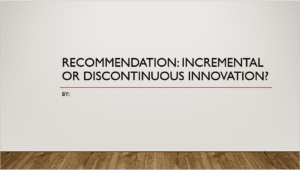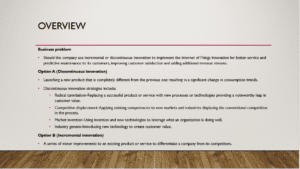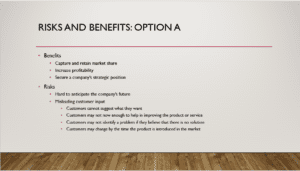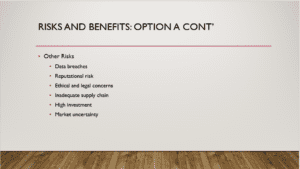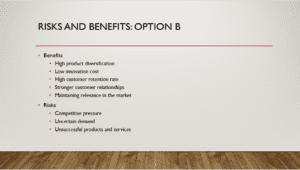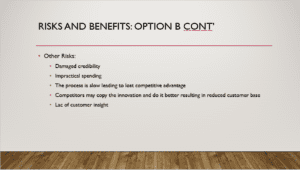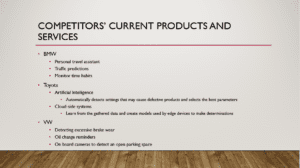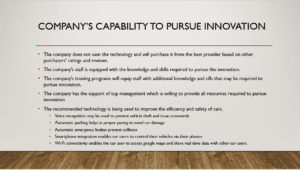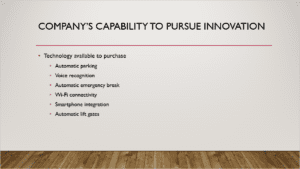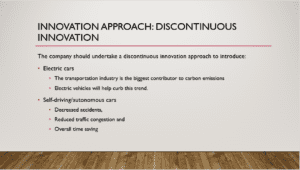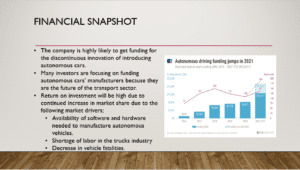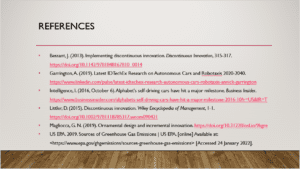Recommendation – Incremental or Discontinuous Innovation?
Hello, and welcome to this innovation recommendation presentation. This presentation will review concepts relating to incremental and discontinuous innovation in the implementation of the identified business solution.
The business problem that needs to be resolved is whether the company should use incremental or discontinuous innovation to implement the Internet of Things Innovation for better service and predictive maintenance to its customers, improving customer satisfaction and adding additional revenue streams. Discontinuous innovation includes launching a new product entirely different from the previous one, resulting in a significant change in consumption trends (Bessant, 2013). Discontinuous innovation strategies include radical cannibalism, competitive displacement, market invention, and industry genesis. Radical cannibalism includes replacing a successful product or service with new processes or technologies, providing a considerable leap in customer value. Competitive displacement includes applying existing competencies to new markets and industries and displacing conventional competition in the process (Littler, 2015). Market invention comprises using creativity and new technologies to leverage what an organization is doing well. Industry genesis includes introducing new technology to create customer value. According to Magliocca (2019), incremental innovation is characterized by a series of minor improvements to an existing product or service to differentiate a company from its competitors.
The main benefits of discontinuous innovation are capturing and retaining market share by introducing unique products and services that meet customer needs and preferences, increased profitability due to the sale of a wide range of products and services, and securing the company’s strategic position by introducing new products that competitors have not yet introduced. One of the main risks of discontinuous innovation is that it is hard to anticipate the company’s future because the company cannot accurately predict how customers will embrace the new product or service. The second risk is misleading customer input because customers cannot suggest what they want, the customer may not know enough to help in improving the product or service, customers may not identify a problem if they believe that there is no solution, and they may change by the time the product is introduced in the market.
Other risks of discontinuous innovation include data breaches, reputational risk, ethical and legal concerns, inadequate supply chain, high investment, and market uncertainty. Data breaches occur when customers’ private information gathered to design a product that meets specific needs and preferences leaks to unauthorized personnel and competitors intending to steal the innovation and stay ahead of the competition. Reputational risk arises when a company introduces a poor-quality product or a product that harms customers. Producing a product that harms customers also results in ethical and legal concerns. An inadequate supply chain occurs when the supply chain cannot meet the demand for raw materials required to maintain the production of the new product. Discontinuous innovation also requires high investment because it includes introducing a new product or service that has not been produced in the company before. Market uncertainty arises due to the uncertainty of how customers will perceive the new product.
The main benefits of incremental innovation are high product diversification, low innovation cost, high customer retention, stronger customer relationships, and maintaining relevance in the market. High product diversification arises from the gradual improvement of existing products. Innovating gradually is also less costly and allows the company to adjust products based on changes in customer preference, thus increasing customer retention rate and stronger customer retention. A company can also regularly improve its products and services based on consumer demand and preferences, thus maintaining relevance in the market. The main risks of incremental innovation are competitive pressure, uncertain demand, and unsuccessful products and services. Competitive pressure arises from copying innovation due to the low cost of innovation. Companies are also skeptical about how customers perceive the product or service, thus creating uncertain demand. The product or service may also be unsuccessful.
Other risks of incremental innovation include damaged credibility and practical spending. Damaged credibility occurs when a company introduces an unsuccessful product, resulting in impractical spending because there is no return on investment. The incremental innovation process is also slow, leading to lost competitive advantage. Competitors may also copy the invention and do it better, resulting in a reduced customer base. Another risk is a lack of customer insight, which increases the risk of offering an unsuccessful product or service.
BMW currently offers 125 sensors/50 computers offering vehicle control/safety, IFTTT-customized applications, IoT connectivity, and LTE. Toyota currently offers 100 sensors/40 computers enabling vehicle control, social media, safety, entertainment, navigation, and 5G. VW offers 90 sensors/35 computers for vehicle control, maintenance, in-car consumer experience.
BMW’s products and services include a personal travel assistant, inbuilt traffic predictions, and sensors to monitor time habits, enabling users to arrive at their destination on time by warning them when they are getting late. Toyota has invested in artificial intelligence to automatically detect settings that may cause defective products and select the best parameters. Toyota has also invested in cloud-side systems to learn from the gathered data and create models used by edge devices to make determinations. VW has sensors that detect excessive brake wear, oil change reminders, and onboard cameras to detect an open parking space.
BMW uses predictive modelling to anticipate future system failures, reduce equipment downtimes and prioritize inspections. On the other hand, Toyota has wireless EV charging, while VW has cylinder deactivation and car-net technology to track a vehicle and determine its real-time location remotely.
The company does not own the technology and will purchase it from the best provider based on other purchasers’ ratings and reviews. However, the company’s staff is equipped with the knowledge and skills required to pursue innovation. The company’s training programs will equip staff with additional knowledge and skills needed to pursue innovation. The company has the support of top management, which is willing to provide all resources required to pursue innovation.
The recommended technology is being used to improve the efficiency and safety of cars. For instance, voice recognition may be used to prevent vehicle theft and issue commands, automatic parking helps in proper paring to avoid car damage, automatic emergency breaks prevent a collision, smartphone integration enables car users to control their vehicles via their phones, and Wi-Fi connectivity enables the car user to access google maps and share real-time data with other car users.
The technology available to purchase includes automatic parking, voice recognition, automatic emergency brake, Wi-Fi connectivity, smartphone integration, and automatic lift gates.
The company should undertake a discontinuous innovation approach to introduce new product line of both electric cars and self-driving/autonomous cars. The future of the automotive industry is pointing towards minimization of its carbon footprint through mainstream adoption of electric cars and in the introduction of smart vehicles, requiring little to no driver input.
According to a report by EPA (2019), the transportation industry is the biggest contributor to carbon emissions, emitting an estimated total of 29% of total emissions. This trends calls for new approaches to minimize or eliminate this trend, with electric vehicles being the most effective approach to curb this trend.
On the other hand, with the experienced continued interconnectivity, autonomous cars are becoming more and more of a reality and set to take over the automotive industry. This new technology will see major benefits like decreased accidents, reduced traffic congestion and overall time saving.
The total market value for autonomous cars is estimated to be $2.5 trillion annually by 2040 (Garrington, 2019). The increase in the market share of autonomous cars is attributed to research projects that review the features and benefits of autonomous vehicles. Autonomous vehicles are also gaining popularity due to the rise of mobility-as-a-service, increasing travel demand, and replacing private driving. Sales may be less during the first years due to barriers such as high prices of technological components required to manufacture autonomous cars, differing degrees of consumer trust in technology, and lack of proper regulations (Intelligence, 2016).
The company is highly likely to get funding for the discontinuous innovation of introducing autonomous cars. Many investors are focusing on funding autonomous cars manufacturers because they are the transport sector’s future. Return on investment will be high due to continued increase in market share due to market drivers such as availability of software and hardware needed to manufacture autonomous vehicles, shortage of labor in the trucks industry, and decrease in vehicle fatalities.
Bessant, J. (2013). Implementing discontinuous innovation. Discontinuous Innovation, 315-317. https://doi.org/10.1142/9781848167810_0014
Garrington, A. (2019). Latest IDTechEx Research on Autonomous Cars and Robotaxis 2020-2040. https://www.linkedin.com/pulse/latest-idtechex-research-autonomous-cars-robotaxis-annick-garrington
Intelligence, I. (2016, October 6). Alphabet’s self-driving cars have hit a major milestone. Business Insider. https://www.businessinsider.com/alphabets-self-driving-cars-have-hit-a-major-milestone-2016-10?r=US&IR=T
Littler, D. (2015). Discontinuous innovation. Wiley Encyclopedia of Management, 1-1. https://doi.org/10.1002/9781118785317.weom090421
Magliocca, G. N. (2019). Ornamental design and incremental innovation. https://doi.org/10.31228/osf.io/9kgre
US EPA. 2019. Sources of Greenhouse Gas Emissions | US EPA. [online] Available at: <https://www.epa.gov/ghgemissions/sources-greenhouse-gas-emissions> [Accessed 24 January 2022].
ORDER A PLAGIARISM-FREE PAPER HERE
We’ll write everything from scratch
Question
Overview
In the highly competitive automotive market, it is critical to keep up with current technology to stay in or get ahead in the marketplace. To remain competitive, companies must innovate and integrate new technologies within their product lines and services.

Recommendation – Incremental or Discontinuous Innovation.
Scenario
You work as a middle manager for one of the top U.S. producers of luxury and mass-market automobiles and trucks.
The chief technology officer (CTO) of the company from the course scenario has been monitoring new technology developments that the company could integrate into its vehicles to enhance the usefulness of and improve access to the data acquired by the many digital sensors integrated into vehicle subsystems over the past 20 to 30 years. The technology trend of particular interest is the Internet of Things (IoT)—the interconnection of embedded devices, such as sensors and computers, over the Internet. By taking advantage of this trend, the CTO believes the company can seize an opportunity to provide better service and predictive maintenance to its customers, improving customer satisfaction and adding additional revenue streams.
Based on briefings by the CTO and your Module One memo, senior management has decided to implement IoT into its product line. Your CTO has asked you to lead a cross-functional team to take this initiative forward. Your first task is to create a presentation that will include your recommendation for how the company should approach this business problem: should you use incremental or discontinuous innovation?
Specifically, should the company:
- Design a completely new product line based on the new technology (discontinuous innovation)
or
- Add new technology features first into one model and then incrementally into the broader product line (incremental innovation)
The recommendation you and your team will make is an important first step in pursuing this new technology. Your presentation and recommendations will be reviewed by senior management. Until senior management approves your approach to this innovation, your cross-functional team will not have a budget and will not be able to start work on the innovation. You should utilize your work from the Module Two presentation and data analysis when justifying your recommendation for this first milestone. In Milestone Two, you will subsequently develop a go-to-market strategy. For your project in Module Nine, you will compile your work from Milestones One and Two and include a proposed organizational structure to best integrate, produce, and market the new technology.
Prompt
Create a PowerPoint presentation to make a recommendation for how the company should pursue the IoT technology to remain competitive, either by discontinuous or incremental innovation. To make your recommendation, you will need to identify how the evolving IoT (sensor) technology fits into the company’s products and services and determine potential risks and benefits. You will also need to look at your competitors to see what they are doing. Finally, you need to analyze the company’s capability (resources) for pursuing the innovation. Use the information and data from the CTO Brief, Comparative Growth Data, Comparative Operating Statistics, and Comparative Product Plans to complete this milestone.
- Explain potential risks and benefits for options A and B.
-
- Overview (1 slide): Present the business problem and options A and B.
- Option A (1–2 slides): Explain at least two potential risks and benefits for option A.
- Option B (1–2 slides): Explain at least two potential risks and benefits for option B.
- Compare your competition’s products and services.
-
- Competitors (3–4 slides): Evaluate the competitors’ current products and services.
-
-
- What are your competitors’ current products and services?
- Are your competitors expanding in the current market? Explain how this impacts their market strength.
-
- Analyze your company’s capability to pursue innovation.
-
- Complete a partial gap analysis (2 slides):
-
-
- Does your company own the technology, or does it need to be purchased?
- How is the technology currently being used in today’s products and services?
- What type of technology is available to purchase?
-
- Recommend the innovation approach your company should pursue.
-
- Innovation approach (2 slides): Explain which innovation approach you are recommending and why.
-
-
- Consider the different stakeholders—research and development (R&D), marketing, and finance—when communicating your recommendations.
- Include a description of the incremental or discontinuous product that you are recommending for R&D.
- Include the sales forecasts for marketing.
- Include a financial snapshot for finance.
- Consider the different stakeholders—research and development (R&D), marketing, and finance—when communicating your recommendations.
-

